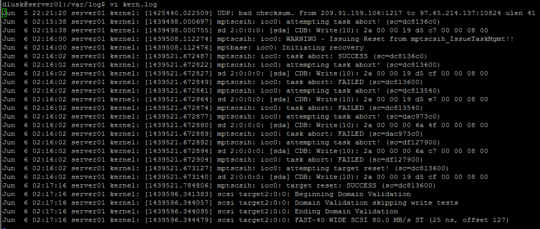9
4
I was going to install VMWare tools on an Ubuntu server Virtual Machine, but I ran into the issue of not being able to create a cdrom directory in the /mnt directory. I then tested to see if it was just a permissions issue, but I couldn't even create a folder in the home directory. It continues to state that it is a read only file system. I know a little about Linux, and I'm not comfortable with it yet. Any advice would be much appreciated.
Requested Information from a comment:
username@servername:~$ mount
/dev/sda1 on / type ext4 (rw,errors=remount-ro)
proc on /proc type proc (rw)
none on /sys type sysfs (rw,noexec,nosuid,nodev)
none on /sys/fs/fuse/connections type fusectl (rw)
none on /sys/kernel/debug type debugfs (rw)
none on /sys/kernel/security type securityfs (rw)
udev on /dev type tmpfs (rw,mode=0755)
none on /dev/pts type devpts (rw,noexec,nosuid,gid=5,mode=0620)
none on /dev/shm type tmpfs (rw,nosuid,nodev)
none on /var/run type tmpfs (rw,nosuid,mode=0755)
none on /var/lock type tmpfs (rw,noexec,nosuid,nodev)
none on /lib/init/rw type tmpfs (rw,nosuid,mode=0755) binfmt_misc on /proc/sys/fs/binfmt_misc type binfmt_misc (rw,noexec,nosuid,nodev)
For sure root output.
root@server01:~# mount
/dev/sda1 on / type ext4 (rw,errors=remount-ro)
proc on /proc type proc (rw)
none on /sys type sysfs (rw,noexec,nosuid,nodev)
none on /sys/fs/fuse/connections type fusectl (rw)
none on /sys/kernel/debug type debugfs (rw)
none on /sys/kernel/security type securityfs (rw)
udev on /dev type tmpfs (rw,mode=0755)
none on /dev/pts type devpts (rw,noexec,nosuid,gid=5,mode=0620)
none on /dev/shm type tmpfs (rw,nosuid,nodev)
none on /var/run type tmpfs (rw,nosuid,mode=0755)
none on /var/lock type tmpfs (rw,noexec,nosuid,nodev)
none on /lib/init/rw type tmpfs (rw,nosuid,mode=0755) binfmt_misc on /proc/sys/fs/binfmt_misc type binfmt_misc (rw,noexec,nosuid,nodev)


I know this is a late answer to the question @socken23 asked, but I just noticed it and it may help someone else in the same situation reading the question. The directory /mnt/cdrom does not necessarily have to exist. If it doesn't exist, you can just run the command "mkdir /mnt/cdrom" to create it. – David – 2014-07-10T03:08:01.313
1Can you please print the output of the "mount" command ? (no parameters needed) – pgruetter – 2010-11-04T15:07:50.110
Added to the answer. Thanks for asking for helpful information. – David – 2010-11-04T15:24:08.350
Just to be sure: "sudo mkdir /mnt/cdrom" fails, right? – Janne Pikkarainen – 2010-11-04T15:51:49.373
What confuses me is that it says it's a read only file system. The output of the command states "rw" which is read write filesystem. So the filesystem itself should be ok. Which folder are you trying to write to? Can you also give the output of "ls -la <the_folder>" ? – pgruetter – 2010-11-04T15:52:41.977
I added a picture to the bottom which is a picture of what I get when I do the requested command. Let me know if you need me to do anything else. :) – David – 2010-11-04T16:12:20.550
I just realized you are about to install VMware Tools. If you are doing that by the book, then the /mnt/cdrom gets automatically mounted by VMware and the most complicated thing you need to do is
mount /dev/cdrom /mnt/cdromif /mnt/cdrom is not already accessible. – Janne Pikkarainen – 2010-11-04T16:15:44.620Another stupid question. Does /mnt/cdrom already exist?? – pgruetter – 2010-11-05T07:31:57.643